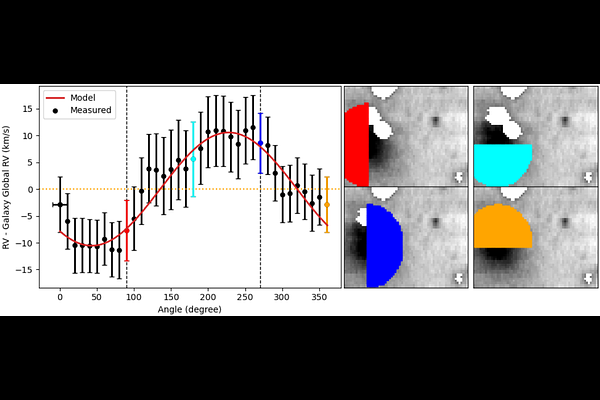A Comprehensive Look at PUDG-R21: Stellar Population and Kinematics of a Globular Cluster-Rich Ultra-Diffuse Galaxy in the Perseus Cluster

A Comprehensive Look at PUDG-R21: Stellar Population and Kinematics of a Globular Cluster-Rich Ultra-Diffuse Galaxy in the Perseus Cluster
Arsen Levitskiy, Duncan A. Forbes, Jonah S. Gannon, Anna Ferré-Mateu, Aaron J. Romanowsky, Jean P. Brodie, Warrick J. Couch, Lydia Haacke
AbstractWe present the analysis of the stellar populations and kinematics of the globular cluster (GC) rich ultra-diffuse galaxy, PUDG-R21, using spectroscopic observations obtained with the Keck Cosmic Web Imager (KCWI). The recessional velocity is measured to be 5536$\pm$10 km s$^{\mathrm{-1}}$, confirming its association with the Perseus cluster. The galaxy exhibits mild rotation of 15.6$\pm$10 km s$^{\mathrm{-1}}$ and a stellar velocity dispersion of 19.4$\pm$3.5 km s$^{\mathrm{-1}}$ within the galaxy effective radius. From this, we infer a dynamical mass of M$_{\mathrm{dyn}}=9.3\pm3.3\times10^{8}$ M$_{\odot}$. Based on a halo mass derived from PUDG-R21 GC counts, we find our dynamical mass is consistent with a cored dark matter profile. The integrated stellar population analysis reveals a predominantly old stellar population of 10.4$\pm$1.2 Gyr, with intermediate-low metallicity ([M/H]=-0.64$\pm$0.12 dex) and elevated alpha abundances ([Mg/Fe]=0.38$\pm$0.25 dex). The inferred star formation history suggests rapid stellar assembly, likely truncating prior to or during the galaxy's infall into the cluster at an early epoch ($\sim$10 Gyr ago). The analysis of stellar population gradients (age and metallicity) indicates a flat profile out to one effective radius. Here, we consider the involvement of two star formation events, initially forming a large population of metal-poor globular clusters, and then the latter contributing to the more metal-enriched diffuse stellar body. The evidence of subsequent star formation suggests this galaxy is more like an extension of the classical dwarf population than the much discussed failed galaxy UDGs.